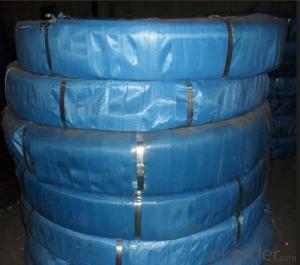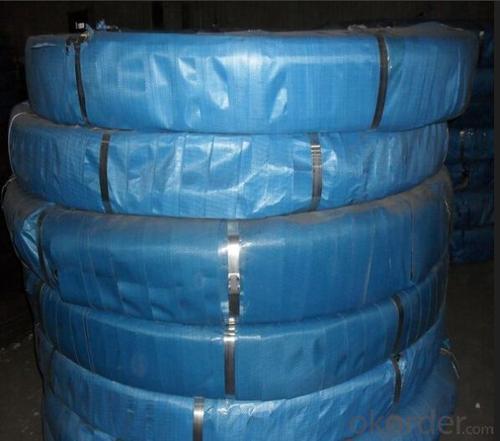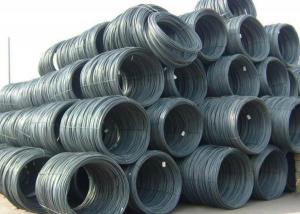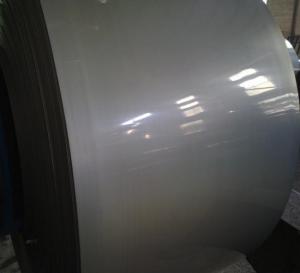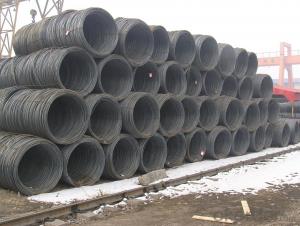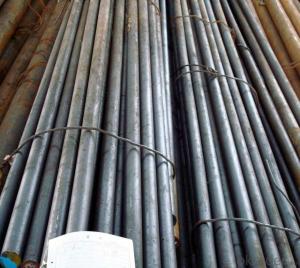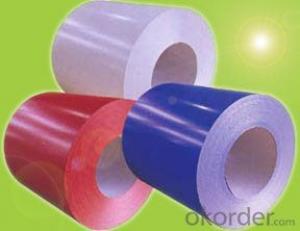Prestressed Hot Rolled Steel Wires
- Loading Port:
- China Main Port
- Payment Terms:
- TT or LC
- Min Order Qty:
- -
- Supply Capability:
- -
OKorder Service Pledge
OKorder Financial Service
You Might Also Like
Quick Details
| Steel Grade: | SWRH77B, SWRH82B | Standard: | ASTM,BS,GB,JIS | Wire Gauge: | 4.0mm-10.0mm |
| Place of Origin: | Tianjin China (Mainland) | Type: | Drawn Wire,Spiral/Helical Ribs, Round Plain | Application: | Construction |
| Alloy Or Not: | Is Alloy | Special Use: | Free Cutting Steel | Model Number: | 4.0-10.0mm |
| Product Name: | prestressed steel wire 4mm high carbon steel wire | Size: | 4.0-10.0mm | ||
| Strength: | 1570/1670/1770/1860 N/mm2 | Relaxation: | Less than 2% (1000hour) | Elongation: | Not less than 4% |
| MOQ: | 10 Tons | Payment: | TT, LC | Delivery: | 10-15 work days |
| Package: | As your requirements |
Packaging & Delivery
| Packaging Detail:steel strand coil to be packed in damp proof materials strapped with 8 bands on one wooded pallet with an outer layer of plastic used for anti-rainshower 2 or 3 wooden block undermeath each coil. | |
| Delivery Detail:within 2 weeks |
Specifications
high carbon class A steel wire
Constructon:7 steel wire
material:wire 82B
FAQ of Prestressed steel wires:
①How is the quality of your products?
Our products are manufactured strictly according to national and internaional standard, and we take a test
on every product before delivered out. If you want see our quality certifications and all kinds of testing report, please just ask us for it.
Guaranteed: If products’ quality don’t accord to discription as we give or the promise before you place order, we promise 100% refund.
②How about price?
Yes, we are factory and be able to give you lowest price below market one, and we have a policy that “ for saving time and absolutely honest business attitude, we quote as lowest as possible for any customer, and discount can be given according to quantity”,if you like bargain and factory price is not low enough as you think, just don’t waste your time.Please trust the quotation we would give you, it is professional one.
③Why should you chose us?
Chose happens because of quality, then price, We can give you both.Additionally, we can also offer professional products inquiry, products knowledge train(for agents), smooth goods delivery, exellent customer solution proposals.Our service formula: good quality+good price+good service=customer’s trust
SGS test is available, customer inspection before shipping is welcome, third party inspection is no problem.
Prestressed Hot Rolled Steel Wires Images
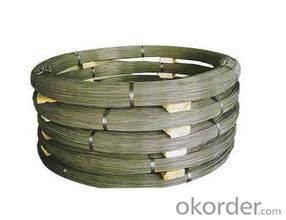

Any question, pls feel free to contact us !
- Q: What are the different types of steel wire rod surface defect classification and grading systems?
- There are several types of steel wire rod surface defect classification and grading systems used in the industry. Some common ones include the ASTM E45 standard, which classifies defects based on their size and severity, and the ISO 4962 standard, which further categorizes defects into specific types such as cracks, scales, and pits. Additionally, some companies may have their own internal systems tailored to their specific production processes and quality requirements.
- Q: What are the different sizes of steel wire rod available?
- The sizes of steel wire rod available vary depending on the specific requirements and applications. Common sizes range from 5.5mm to 16mm in diameter, with variations in length and weight. Custom sizes can also be produced to meet specific needs.
- Q: How does the hardness of steel wire rod vary with different heat treatment processes?
- The hardness of steel wire rod can vary significantly with different heat treatment processes. Through processes like annealing, the steel wire rod can become softer and more ductile, resulting in lower hardness. On the other hand, processes like quenching and tempering can increase the hardness of the steel wire rod by transforming its microstructure, making it stronger and more resistant to deformation. Therefore, the specific heat treatment process employed determines the hardness of the steel wire rod.
- Q: What are the main factors influencing the choice of steel wire rod order payment method?
- The selection of the payment method for steel wire rod orders can vary based on the specific circumstances and preferences of the parties involved. However, there are common factors that typically play a role, including: 1. Transaction volume and frequency: If the buyer and seller have a long-term and high-volume relationship, they may choose a more convenient and efficient payment method, such as open account or letter of credit. This eliminates repetitive paperwork and bank involvement, ensuring smoother and quicker transactions. 2. Trust and creditworthiness: If there is a lack of trust between the buyer and seller, or if the buyer's creditworthiness is questionable, the seller may prefer more secure payment methods like advance payment or documentary collection. These methods provide assurance that payment will be made before the goods are delivered. 3. Cost and convenience: The cost and convenience of different payment methods can also affect the decision. For example, if the buyer wants to avoid additional fees or charges associated with certain payment methods, they may choose cash in advance or electronic funds transfer. Conversely, if the seller wants to minimize administrative burden or payment processing costs, they may prefer open account or electronic payments. 4. Country-specific regulations and customs: Each country has its own regulations and customs regarding international trade and payment methods. For instance, certain countries may restrict certain payment methods or require specific documentation for customs clearance. Sellers and buyers must consider these factors when selecting a payment method. 5. Payment security and risk mitigation: The desired level of payment security and risk mitigation by the buyer and seller can also influence the choice of payment method. Methods like letter of credit or documentary collection offer higher security and risk mitigation compared to open account or cash in advance. 6. Market norms and industry practices: Prevailing market norms and industry practices can also impact the selection of payment methods. In some industries or regions, specific payment methods may be commonly used due to historical practices or preferences. In conclusion, the main factors influencing the choice of payment method for steel wire rod orders include transaction volume and frequency, trust and creditworthiness, cost and convenience, country-specific regulations and customs, payment security and risk mitigation, as well as market norms and industry practices. It is crucial for both the buyer and seller to carefully evaluate these factors in order to select the most suitable payment method for their specific situation.
- Q: What are the different surface finishing materials used for steel wire rod?
- Steel wire rod can be finished with various materials, each offering unique advantages. Common options include: 1. Galvanizing: Also known as zinc coating, this method involves applying a layer of zinc to the wire rod's surface using hot-dip or electroplating techniques. The zinc coating acts as a sacrificial anode, guarding against corrosion and providing excellent rust protection. 2. Phosphate Coating: This technique involves treating the wire rod with a phosphate solution, resulting in a thin layer of phosphate crystals on the surface. This coating enhances the adhesion of subsequent coatings and improves corrosion resistance. 3. Epoxy Coating: A thermosetting polymer, epoxy coating is applied as a protective layer on the wire rod's surface. It offers exceptional resistance to chemicals, abrasion, and corrosion, thus increasing the rod's durability and lifespan. 4. Powder Coating: This popular method uses an electrostatic process to apply a dry powder to the wire rod's surface. The powder is then cured under heat, forming a durable and attractive coating. Powder coating provides a wide range of colors and finishes, improved resistance to chipping and scratching, and enhanced corrosion protection. 5. Chrome Plating: In this process, a layer of chromium is deposited onto the wire rod's surface. Chrome plating not only offers excellent corrosion and wear resistance but also provides a decorative finish. It is commonly used when aesthetics, durability, and corrosion protection are essential. 6. Nickel Plating: Nickel plating involves depositing a layer of nickel onto the wire rod's surface. This plating enhances corrosion resistance, creates a bright finish, improves solderability, and facilitates better electrical conductivity. These are just a few examples of the diverse range of surface finishing materials used for steel wire rod. The choice of coating or plating depends on specific application requirements, such as corrosion resistance, aesthetics, and functional properties.
- Q: What are the factors that influence the mechanical properties of steel wire rod?
- The factors that influence the mechanical properties of steel wire rod include the composition of the steel, the heat treatment processes it undergoes, the manufacturing techniques used, and any additional treatments or coatings applied to the rod. Additionally, factors such as the diameter and surface finish of the wire rod can also impact its mechanical properties.
- Q: How is steel wire rod used in the manufacturing of wire for thermal insulation?
- Steel wire rod is an essential component in the manufacturing process of wire for thermal insulation. It is used as the raw material for producing the wire that forms the foundation of thermal insulation products. The process begins with steel wire rod being fed into a wire drawing machine. This machine reduces the diameter of the wire rod through a series of dies, resulting in finer and thinner wire. The drawn wire is then further processed to achieve the desired diameter and strength required for thermal insulation applications. Once the wire has been drawn to the required specifications, it is coated with a specialized insulation material. This insulation material could be a polymer, rubber, or other thermally insulating substance. The coating process ensures that the wire is adequately protected and provides enhanced thermal insulation properties. The coated wire is then wound into coils or spools, ready to be used in various thermal insulation applications. It is commonly utilized in products such as heating cables, resistance wires, or as a reinforcement component in thermal insulation materials. The steel wire rod used in the manufacturing of wire for thermal insulation is chosen for its strength, durability, and ability to withstand high temperatures. It provides the necessary structural integrity to maintain the shape and effectiveness of the insulation product. In summary, steel wire rod is a crucial element in the production of wire for thermal insulation. It undergoes various processing steps, including wire drawing and coating, to create a high-quality product that offers excellent thermal insulation properties.
- Q: What are the different surface finishes available for steel wire rod?
- Some of the different surface finishes available for steel wire rod include black, pickled and oiled, galvanized, and coated with various types of finishes such as epoxy or zinc.
- Q: 8 wire rods, one meter, how many kilograms?
- Wire rods, also known as wire rods, steel, wire, rod (s), usually refer to small diameter round steel discs. The diameter of the wire rod is in the range of 5-19 millimeters (usually 6-9 mm), and its lower limit is the minimum size of the hot-rolled steel section.
- Q: What are the common production processes for osmium-coated steel wire rod?
- The common production processes for osmium-coated steel wire rod include wire drawing, cleaning and degreasing, osmium coating through methods like electroplating or physical vapor deposition, and final heat treatment for improved hardness and durability.
Send your message to us
Prestressed Hot Rolled Steel Wires
- Loading Port:
- China Main Port
- Payment Terms:
- TT or LC
- Min Order Qty:
- -
- Supply Capability:
- -
OKorder Service Pledge
OKorder Financial Service
Similar products
Hot products
Hot Searches
Related keywords
